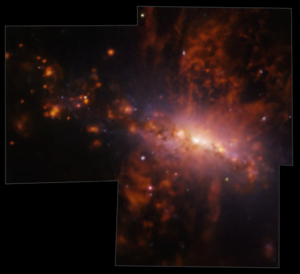In a study published in the journal Monthly Notices of the Royal Astronomical Society, a team of international researchers has created the first high-resolution map of an enormous explosion in the neighboring galaxy NGC 4383, which will provide light on how elements contaminate the space between galaxies.

Gas (in red, top and bottom) is ejected from the nearby galaxy NGC 4383. Image Credit: Watts et al., 2024
Researchers investigated the galaxy NGC 4383 in the neighboring Virgo cluster, discovering a massive gas outflow that light would take 20,000 years to get from one side to the other.
This gas outflow is caused by highly intense stellar explosions in the galaxy’s central regions, which can emit massive amounts of hydrogen and heavier elements. The amount of gas discharged is equivalent to more than 50 million Suns.
Dr. Adam Watts, the study lead author from the University of Western Australia node at the International Centre for Radio Astronomy Research (ICRAR), stated that outflows are difficult to detect. Thus, little is known about their physics and features.
The ejected gas is quite rich in heavy elements giving us a unique view of the complex process of mixing between hydrogen and metals in the outflowing gas. In this particular case, we can detect oxygen, nitrogen, sulphur and many other chemical elements.
Dr. Adam Watts, Study Lead Author and Research Associate, International Centre for Radio Astronomy Research
Gas outflows are critical in determining how quickly and how long galaxies can produce stars. The gas expelled by these explosions pollutes the space between stars inside a galaxy and even across galaxies and can remain in the intergalactic medium indefinitely.
The high-resolution map was created using data from the MAUVE survey. The study utilized the MUSE Integral Field Spectrograph at the European Southern Observatory’s Very Large Telescope, situated in northern Chile.
ICRAR researchers Professors Barbara Catinella and Luca Cortese, co-authors of the study and co-leaders of MAUVE, said, “We designed MAUVE to investigate how physical processes such as gas outflows help stop star formation in galaxies. NGC 4383 was our first target, as we suspected something very interesting was happening, but the data exceeded all our expectations.”
MAUVE observations in the future should provide an extensive understanding of the significance of gas outflows in the local Universe.
Journal Reference:
Watts, A. B., et. al. (2024) MAUVE: a 6 kpc bipolar outflow launched from NGC 4383, one of the most H I-rich galaxies in the Virgo cluster. Monthly Notices of the Royal Astronomical Society. doi:10.1093/mnras/stae898